![]() Attach
|
Attach
|
![]() Edit
|
Edit
|
![]() Revisions
Revisions
![]() Related Content
Related Content
Macro Photography Gears

If you love capturing the intricate details of tiny objects, like bugs of flowers, there is no better way than through macro photography. Also known as macrography, photomacrography and macrophotography, macro photography is extreme close-up photography where the resulting photograph is much greater than the actual size of the subject. This is achieved by using special lenses, which allow you to focus very closely on the subject, like the ones described below.
Bellow
A Bellow, in photography, is a pleated, expandable part of a medium to large format camera. With the success bellow garnished in macro photography, several manufacturers also produces bellows for small format camera.
The bellow allows a lens to be moved in respect to the focal plane of focusing. By moving the lens further away from the film (sensor) plane, you move its focal point closer to the lens. At the same time, you lose infinity focus, which is not exactly needed in macro photography.
There are two kinds of bellows that are usually used on cameras. These are bag bellows, which are normally used with a short focal length lens and the accordion bellows, used in the same way but with a much longer range extension. The best way to use a bellows is with a tripod to allow for more stability when adjusting the distance between the camera and the subject.
A bellows macro lens that has a short focal length of between 12.5mm to 38 mm, will provide a magnification of between x3 to x20. Because they do not have a focusing mechanism, they cannot be mounted directly onto a camera but instead they are used either with an extension bellows or a variable extension tube and a macro stand. A bellows macro lens should never be used in reverse because they are already designed for larger than life photographs.
Pros
Excellent results when used properly, provides a dark and flexible extension between the lens and the film plane.
Cons
They can be expensive, they need special focusing screens for higher magnifications, need a tripod or macro stand, not available with autofocus, must have an extension bellows to change magnification.
Close-Up Lens
A close-up lens, filter or macro filter is a secondary lens used in macro photography that does not require the use of a specialised primary lens. It is the same concept as reading glasses (or a magnifying glass) allowing the primary lens of the eyes to focus more closely. Normally mounted on the filter thread of the primary lens, close-up lenses are sold by suppliers that manufacture photographic filters. These lenses are also commonly referred to diopters, which is after the unit of measurement of their particular optical power. You can get high-quality close-up lenses that are composed of achromatic doublets that have the ability to produce excellent images with a low loss of sharpness.
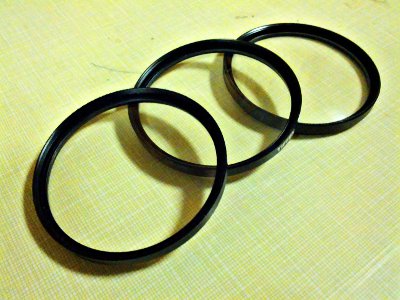
Usually, a close-up lens is marked with a +d number, which is the diopter unit or the power of the lens. The power of the lens or the diopter is defined as 1000/f and f is what the focal length is in mm. As such, a 50mm lens has a diopter of +20, which is equal to 1000/50 and a close-up lens with a +4 diopter has a 250 mm focal length, which is 1000/4. In addition, the larger the diopter value, the higher the magnification.
Typical close-up lens set comes with three lenses: +1, +2, and +4. Using two of three of these lenses together gives you a full combination of diopter up to +7. For example, using the +2 lens and the +4 lens together gives you +6 diopter lens.
Pros
Close-up lenses were designed for use as telephoto macro. A close-up lens will magnify an image before it enters the main lens and there is no loss of light and actually brightens the image. Easy to screw or snap on.
Cons
The glass quality of the close-up lens may not be the same quality of your camera which may cause image deterioration.
Extension Tubes
Extension tubes are also called extension rings and can be interchanged with other lenses to get a closer focus. Extension tubes extend the focal plane to gain maximum magnification. Using extension tubes requires a longer exposure time because of the loss of light. Unless your extension tube has electrical contacts, you will not be able to use the autofocus on an automatic camera; meaning you will have to manually focus the camera. The newer, more expensive extension tubes come with electrical contacts.
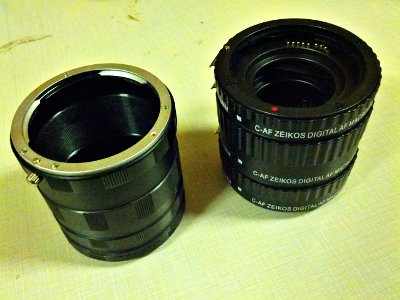
You can get an extension tube for nearly every single lens reflex (SLR) body that can be attached to a variety of different lenses to attain different effects. Plus, they do not cost as much as dedicated macro lenses. Generally speaking, the greater the minimum focal distance, the greater the magnification. In fact, the lens creates a "narrow focus zone", in which an object can be focused. For example, with a 50mm lens and an extension tube, the minimum focal distance is about 4 inches with a depth of field that is extremely narrow.
Pros
Enhances the lens capability, gives a degree of macro capability, allows a lens to focus much closer, allows you to convert most lenses into a macro lens for much less cost. No additional lens to deteriorate image quality.
Cons
Loss of light, which increase exposure time and may require you to manually focus.
Macro Lens
Macro lenses are specifically designed for extreme close-up work. This extreme close-up photography opens up a whole new world of subject matter. One of the best macro lenses for the money, on the market today is the Canon EF 100mm f/2.8 USM and is an excellent choice for someone just starting out in macro photography. A true macro lens has the ability to capture a subject on the sensor at the same size as the actual subject; this is called, 1:1 or 1.0X macro magnification. Most macro lenses have the ability to focus continuously to infinity with excellent quality.
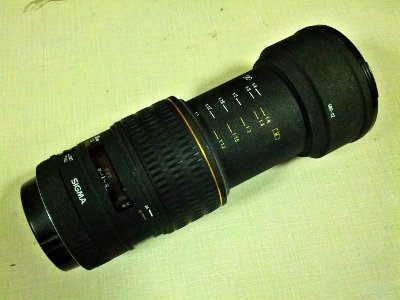
A true macro lens can achieve a larger than life size magnification, which will enable the photographer to achieve extreme details of miniscule objects such as insect eyes and snowflakes. Focal length can affect other aspects of macro photography. A longer focal length macro lens will help you keep your distance to a timid subject. It also helps you blur out the background. A shorter focal length macro lens lets you get close and personal. Also, a shorter focal length macro lens with a wider angle of view mean you will be able to shoot your subject with a background in the photograph.
Pros
Ability to focus continuously to infinity with excellent quality; you can use it as a regular lens. Possible to achieve larger than life size magnification. High image quality.
Cons
Costly. Larger and heavier.
Reverse Lens Adapter
A reverse lens adapter allows you to turn the lens around backwards on your camera and show you an amazing magnification that you have never seen before. If you have a DSLR or an SLR that has an automatic setting, you will have to put it on manual focus because the auto focus feature will not work with the lens turned around backwards; old manual focus camera�s work best with this technique. (Or see our "Hacking Digital Camera" book on how to build a reverse lens adapter with with electrical contacts.)
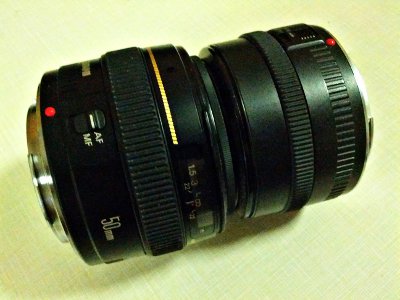
The best way to focus this way is by simply moving the camera back and forth until the subject is in focus, use a tripod with an adjustment knob to turn to move the camera. There also will not be an auto aperture either so you will have to learn how to use the aperture ring on your camera. Ordinarily, the camera keeps the aperture open so you can see what you are taking a picture of through the viewfinder and then just before taking the photo, it stops down to the appropriate size.
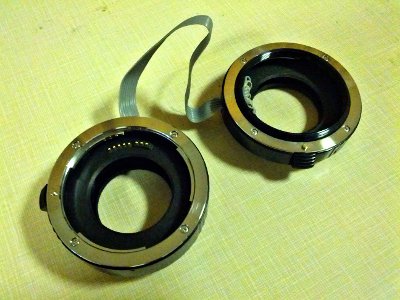
Pros
Much less expensive than a close-up lens or a macro lens, not limited to using only one lens
Cons
No auto-focus. No auto exposure.
Teleconverter
There are two types of teleconverters. Teleconverters for SLR fits between the camera body and the lens. Teleconverters for cameras without interchangeable lenses, where they are attached to the front of the lens.
SLR Teleconverter
Also called a tele extender, a teleconverter is a second lens that is mounted between the body of the camera and the photographic lens. What it does is enlarge the middle part of the image that is obtained by the objective lens. A teleconverter lens consist of several lenses that act together as a single lens, thus enlarging the central part of the image.
If used with a slow lens, they may reduce the aperture to the point where the camera�s autofocus will not work; depending on your camera�s system. Typically a 2x teleconverter loses 2 stops of light (e.g. f/5.6 aperture becomes f/8). But if you have a fast lens (e.g. f/2.8), you can still auto-focus with a 2x teleconverter (reduces lens to f/5.6). To keep auto-focus with a 2x teleconverter, you need to use a lens of at least f/2.8. For auto-focus with a 1.4x teleconverter, use a lens that is at least f/4.
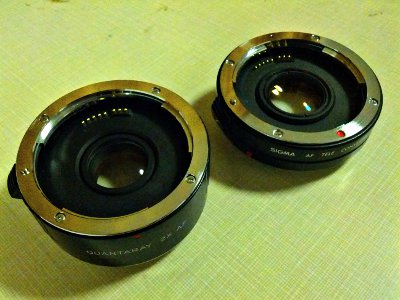
Teleconverters are usually made in 1.4x, 1.7x, 2x. and 3x. 1.4x and 2x are the most common. A 2x teleconverter used on a 35mm camera will enlarge the middle part, 12x18mm, of the image to the size of 24x36mm using the standard 35mm film format. If you are trying to save money, using a teleconverter along with an existing lens is much less expensive than buying a separate, longer telephoto lens.
How does teleconverters help you with macro photography? If you have ever used a telephoto lens, you'll realized that the minimum focus distance is extremely long compared to smaller lenses. When you use teleconverter, the minimum focus distance doesn't change on your lens, but you double the magnification (assuming a 2x teleconverter); the object is twice as big.
Pros
Using a 2x will double your focal length and magnification. Much cheaper than buying a longer telephoto lens.
Cons
High quality teleconverters are built for specific high quality lenses. Generic teleconverters will deteriorate image quality.
Frontal Teleconverters
The frontal teleconverters attach to the front of the lens. They are made for cameras without interchangeable lens. Much like the SLR teleconverters, they come in powers of 1.4x, 1.7x, 2x, etc. The nice benefit of using this type of teleconverter is that there is no light loss compared to the SLR teleconverter. Much like the SLR teleconverter, these frontal teleconverter magnifies the image without increasing minimum focus distance.
So why would anyone go with the SLR teleconverter, rather than these frontal teleconverters? Because these teleconverters are attached to the front of the lens, the teleconverter lens element must be larger than the lens glass on the camera. Therefore, using a high quality glass that large is usually extremely expensive.
To combat the cost, these type of teleconverters are usually only made for small lenses, such as those found on point-and-shoot cameras. It's extremely difficult to find one that fit onto the front of an SLR lens. And if you ever come across such a teleconverter at a good price, be sure to snatch one.
Pros
Using a 2x will double your focal length and magnification. Useable on smaller cameras without interchangeable lens.
Cons
Frontal teleconverters are usually always generically made for multiple cameras; not specialized for quality on any lens.
![]() Attach
|
Attach
|
![]() Edit
|
Edit
|
![]() Revisions
Revisions
![]() Related Content
Related Content
Attachments
- Auto Reverse Adapter.jpg (37 KB)
- Close-Up Lens Set.jpg (37 KB)
- Extension Tube Sets.jpg (34 KB)
- Macro Lens.jpg (31 KB)
- Manual Reverse Adapter.jpg (31 KB)
- Teleconverters.jpg (36 KB)
- Thumbnail.jpg (7 KB)
- Tiny Flower.jpg (41 KB)
198 Users Online
|
$10000-above $5000-$9999 $2000-$4999 $1000-$1999 $500-$999 $200-$499 $100-$199 $50-$99 $25-$49 $0-$24 Gift Certificate |
|




